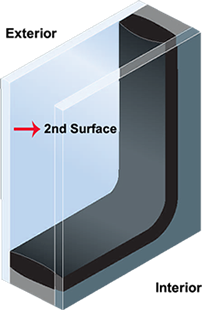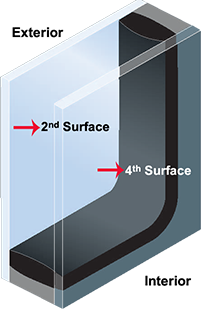
Low Emissivity (Low E) coatings are thin film coatings used to improve thermal efficiency
- Windows emit (or radiate) heat
- The ability of a material to radiate energy is called its emissivity
- This emission of radiant heat is one of the important components of heat transfer for a window
- Reducing the window’s emittance can greatly improve its insulating properties
- Standard clear glass––emissivity of 0.84 (16% is reflected back)
- Low-E glass coatings––emissivity can be as low as 0.04 (96% is reflected back)
Low-E coatings are typically incorporated into the U- factor for the unit or glazing assembly.
The solar reflectance of low-E coatings can be manipulated to include specific parts of the visible and infrared spectrum. This is the origin of the term spectrally selective coatings, which selects specific portions of the energy spectrum, so that desirable wavelengths of energy are transmitted and others specifically reflected. A glazing material can then be designed to optimize energy flows for solar heating, daylighting, and cooling.
 A Low E coating is typically applied to the 2nd surface of an insulated unit to increase energy efficiency, reduce glare and harmful UV rays.
A Low E coating is typically applied to the 2nd surface of an insulated unit to increase energy efficiency, reduce glare and harmful UV rays.
The Advantages of Dual Low E
Surface #2 and #4
 Dual Low E coatings increase the energy efficiency performance without sacrificing design or adding weight and material costs (compared with a triple paned glass unit). Adding a Low-E coating to the #4 surface of the glass unit:
Dual Low E coatings increase the energy efficiency performance without sacrificing design or adding weight and material costs (compared with a triple paned glass unit). Adding a Low-E coating to the #4 surface of the glass unit:
- Reflects infrared heat back into the building
- Reduces the amount of radiant heat loss
through the glass - Improves the thermal insulation by reflecting
room heat back inside. - Improves the overall insulation
and energy efficiency of the IG unit.
Air versus Gas Filled
 Gas is used in Insulated Glass Units (IGU) to improve the energy efficiency of the unit by reducing the overall transfer of heat between the inside and outside. ‘Filling the space with a less conductive, more slow-moving gas minimizes the convection currents within the space, conduction through the gas is reduced, and the overall transfer of heat between the inside and outside is reduced.’ Types of Gas used:
Gas is used in Insulated Glass Units (IGU) to improve the energy efficiency of the unit by reducing the overall transfer of heat between the inside and outside. ‘Filling the space with a less conductive, more slow-moving gas minimizes the convection currents within the space, conduction through the gas is reduced, and the overall transfer of heat between the inside and outside is reduced.’ Types of Gas used:
- Argon––Inexpensive, nontoxic, nonreactive, clear and odorless (optimal spacing for an argon filled unit is ½”)
- Krypton––Nontoxic, nonreactive, clear and odorless and has a better thermal performance, but is more expensive to produce (useful when spacing between glazing must be thinner approx. ¼”)
- Mixture of Argon and Krypton –– Provides better thermal performance than Argon and is less expensive than Krypton
Source: Efficient Windows Collaborative



